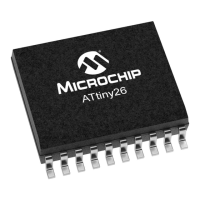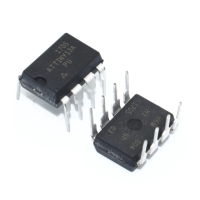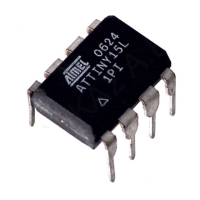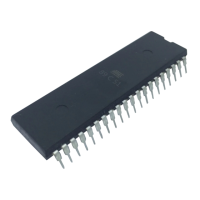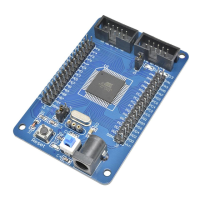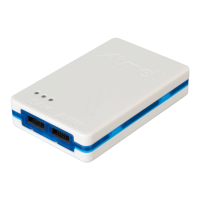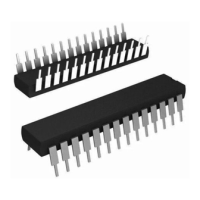122
7598H–AVR–07/09
ATtiny25/45/85
where VPOS is the voltage on the positive input pin, VNEG the voltage on the negative input pin,
and V
REF the selected voltage reference (see Table 18-3 on page 123 and Table 18-4 on page
124). The voltage on the positive pin must always be larger than the voltage on the negative pin
or otherwise the voltage difference is saturated to zero. The result is presented in one-sided
form, from 0x000 (0d) to 0x3FF (+1023d). The GAIN is either 1x or 20x.
18.7.3 Bipolar Differential Conversion
As default the ADC converter operates in the unipolar input mode, but the bipolar input mode
can be selected by writting the BIN bit in the ADCSRB to one. In the bipolar input mode
two-sided voltage differences are allowed and thus the voltage on the negative input pin can
also be larger than the voltage on the positive input pin. If differential channels and a bipolar
input mode are used, the result is
where V
POS is the voltage on the positive input pin, VNEG the voltage on the negative input pin,
and V
REF the selected voltage reference. The result is presented in two’s complement form, from
0x200 (-512d) through 0x000 (+0d) to 0x1FF (+511d). The GAIN is either 1x or 20x.
However, if the signal is not bipolar by nature (9 bits + sign as the 10th bit), this scheme loses
one bit of the converter dynamic range. Then, if the user wants to perform the conversion with
the maximum dynamic range, the user can perform a quick polarity check of the result and use
the unipolar differential conversion with selectable differential input pairs (see the Input Polarity
Reversal mode ie. the IPR bit in the ADCSRB register on page 135). When the polarity check is
performed, it is sufficient to read the MSB of the result (ADC9 in ADCH). If the bit is one, the
result is negative, and if this bit is zero, the result is positive.
18.7.4 Temperature Measurement (Preliminary description)
The temperature measurement is based on an on-chip temperature sensor that is coupled to a
single ended ADC4 channel. Selecting the ADC4 channel by writing the MUX3..0 bits in ADMUX
register to “1111” enables the temperature sensor. The internal 1.1V voltage reference must
also be selected for the ADC voltage reference source in the temperature sensor measurement.
When the temperature sensor is enabled, the ADC converter can be used in single conversion
mode to measure the voltage over the temperature sensor.
The measured voltage has a linear relationship to the temperature as described in Table 51. The
voltage sensitivity is approximately 1 mV /
°C and the accuracy of the temperature measurement
is +/-
10°C after bandgap calibration.
ADC
V
POS
V
NEG
–()512⋅
V
REF
-------------------------------------------------------
GAIN⋅=
Table 18-2. Temperature vs. Sensor Output Voltage (Typical Case)
Temperature / °C -45°C +25°C +105°C
Voltage / mV 242 mV 314 mv 403 mV
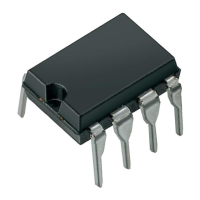
